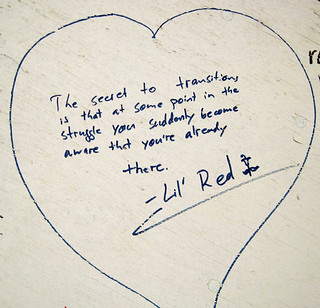 Photo by sparkzy
Photo by sparkzy
I participated in the online facilitation course by
Nancy White (long ago!) when we were practising a chat session, just typing without any audio. The flow was very fast, it was Friday, there were lots of jokes and I was enjoying myself. Suddenly Nancy said - shall we move to a teleconference? So we all dialed in to the teleconference and we didn't know how to continue. The flow was gone... We had to start afresh with our conversation and the line of jokes was gone, because in a teleconference the threshold to throw in a funny line is much higher. It was a good experience to realize that all media have their own affordances. I also realized that the conversation doesn't flow naturally when moving to a different medium.
Blended trajectories
When designing trajectories with an online and face-to-face component you hence need to facilitate these transitions. I've been doing it - sometimes succesfully - but sometimes not at all. The most succesfull transition is in our learning trajectory on social media. We start with 2 weeks online and people are then really eager to meet face-to-face! The are also eager to start online, because they are starting with a new course and are very curious. I decided to ask for some more experiences with facilitating these transitions, on Twitter (thanks
Anjet van Lingen and
Ben Ziegler), and in the Linkedin groups of the LOSmakers and Virtual Facilitation where I also got very useful contributions. Ben has
written a blogpost about the same topic with the great term 'choreographing conversations' and talking about fluidity.
Two examples of a blended design
Nancy Settle- Murphy offered a nice example asked for help in
creating a new strategic plan for a 70- person department. She opened a virtual conference
space where all employees were
invited to answer a few open-ended questions related to strategic
opportunities, threats, etc. and to assess their
workplace culture. Then summary was used to jumpstart a 1-day working session face-to-face with the executive team to come up with 7-9 strategic focus areas. Since she wanted all members of the department to be able to propose ideas and
actions for all initiatives volunteers lead subteams to
brainstorm ideas and propose action plans for each initiative, this was done face-to-face as well. Each session of 7-9 people had a
scribe, who keyed the ideas generated in each session ideas into the virtual conference space. Everyone was then invited to join the online conference area to view ideas, and submit their own ideas. This was used to create detailed
plans.
Vera Hendriks of Agri-ProFocus shared how they use online before a meeting to set the agenda together, then distribute flyers during an event with the web address. After the meeting they post reports and photos online, as well as discussions. People are curious to see the pictures, hence log on and may then contribute as well to discussions.
Nice examples of how you can blend online and face-to-face elements... and make use of the advantage of both modalities. What I like about the example is that the steps are all geared to making optimum use of time and knowledge of participating employees. In other words - you can think strategically about participation in the process.
Commitment and a sense of urgency
The hard part of a blended process is ensuring online participation. What is key to a successful transition is that people feel committed to the process and see and feel the urgency to continue online or start online. People may attend a meeting because they are invited but may more easily ignore an invitation to contribute online. Hence it is very important that there is a clear sense of urgency and that the topic is important enough to deserve more attention. Why would the group continue online or why start online? Without this urgency it might be better not to continue online to avoid disappointment with contributions and avoid that you end up 'pulling a dead horse' (is this an English expression?
).
Seduce
Equally there are ways to seduce people into participation online. A practical example is to post something of interest like photo's and people may be triggered to look at the photo's. You may also give out a price for the best contributors. And seduce by bringing your own enthousiasm.
Be clear about the ending
What is also important is that there is clarity about the online process and that it is not too-open ended; altough in communities it is often more open-ended and spontaneaous. For instance make it clear that you will collect arguments or examples for 2 weeks, then analyze the arguments and end with a poll to vote for the best arguments. Also state when the discussion will close and/or the online space will be closed down.
Some practical tips to facilitate transitions for facilitators
- Think through the overall goal and various online and face-to-face steps and how they are linked. Point out how the steps are linked to eachother. This will help people see the urgency and logic.
- When transitioning from face-to-face to online, make it attractive for people to participate online by offering a 'warm embrace' make sure the online space is attractive, be enthousiastic and be there yourself online.
- Develop a sense for the hot topics with sufficient urgency to attract people's attention for a longer period of time. Look for lead persons to help shape the topics online.
- When transitioning from online to face-to-face make sure you bring product or summaries from the online discussion into the face-to-face. Make that the basis for the next steps.


